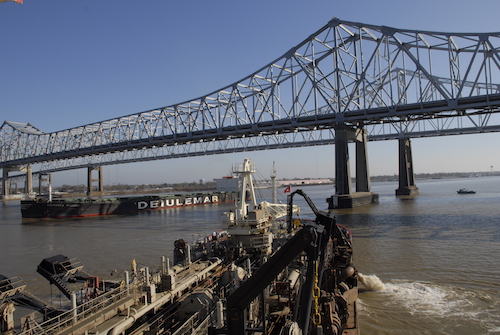U.S. House Democrats unveiled a sweeping plan Thursday to
invest $1 trillion in the nation’s decaying infrastructure, creating 16 million
new American jobs by tackling everything from rickety bridges and railways to
safe water, renewable energy and high-speed internet access.

|
The first span of New Orleans' Crescent City Connection Bridge, built in 1958, is 60 years old. That's nearly 17 years older than the average bridge in the U.S. The American Society of Civil Engineers reports than nearly 9.1 percent of America's bridges, carrying 188 million people per day, are structurally deficient and in need of repair. The rest of ASCE's Infrastructure Report Card is not much kinder to other areas of U.S. infrastructure.
Photo Credit:
Creative Commons/Flickr User
TeamNewOrleans
|
“You cannot build a 21st-century economy on mid-20th-century infrastructure,” said Rep. Elizabeth Esty of Connecticut. “This will transform America.”
Esty was among a half-dozen House Democrats, including Minority Leader Nancy Pelosi, who outlined the “Rebuild America” plan at a morning news conference. Watch it here.
Introducing the wide-ranging proposal, Rep. David Cicilline of Rhode Island said it “is a serious, realistic plan that represents years of work.”
“This proposal from House Democrats fills me with hope about the future of American jobs, and not just in the construction industry,” said International President Lonnie R. Stephenson. “It’s going to take real leadership in Washington and plenty of grassroots support to get an ambitious plan like this through Congress, but it can be done.”
Beyond urgently-needed repairs to roads and bridges, the plan sets goals for safe, efficient, “world-class” mass transit, airports, waterways, schools, water systems, energy efficiency, digital expansion and more.
In addition to an explosion of construction jobs, the plan would put millions of Americans to work throughout the economy, said Rep. Peter DeFazio of Oregon.
“We have the strongest buy-American requirements of any part of the federal government,” he said, describing the diversity of workers who will benefit. “It’s design, it’s engineering, it’s small business, it’s manufacturing, it’s high-tech.”
In a news release, Democrats pledged that projects will use “American iron and steel and American-made green infrastructure materials to support good-paying jobs and small business owners.”
From reinforcing bridges to ensuring safe drinking water, many projects would protect lives. Others would change lives, opening doors that still are closed to millions of Americans.
“Access to quality, affordable high-speed internet is no longer a luxury, it is a necessity for 21st century commerce, education, telemedicine and public safety,” the news release stated. “We will close the rural-urban divide and build out high-speed broadband in unserved and underserved communities.”
A White House infrastructure plan that is expected to be announced Monday also calls for spending $1 trillion, but the federal portion would be far smaller. According to a leaked version, federal funds would cover just $20 billion a year over a decade, while the remaining $800 billion would have to come from state and local budgets, as well as from private profiteers.
Economists haven’t weighed in on other either plan yet. But in recent years, many analysts have urged large national investments in infrastructure, saying they pay for themselves many times over – a “free lunch,” as several financial columnists put it.
While Democrats didn’t go into details of how their plan would be funded, they said it won’t increase the deficit.
“We need a major federal commitment that is sustained,” DeFazio said. If that happens, “the multiplier effect is phenomenal. This is what we need to do to put America back to work again.”